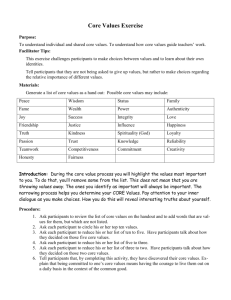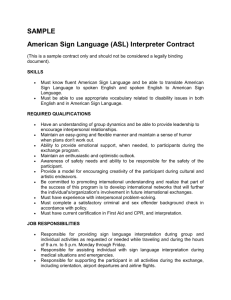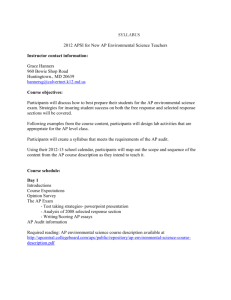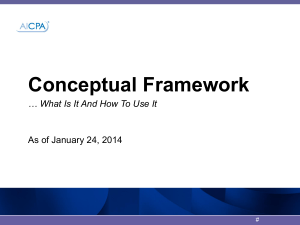2014 Ethics Presentation – Isaac W Choy
advertisement
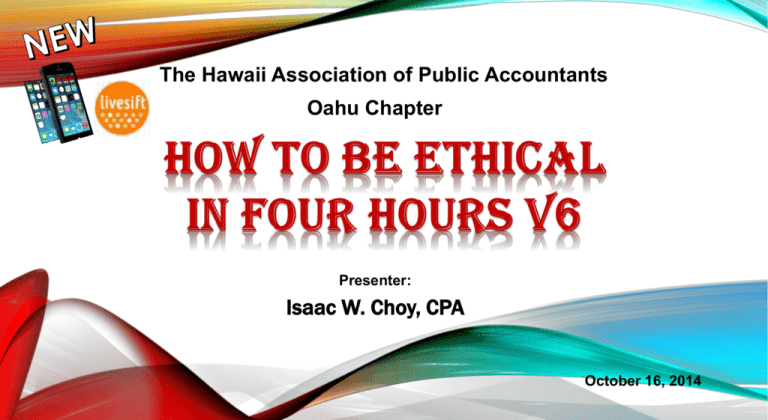
The Hawaii Association of Public Accountants Oahu Chapter Presenter: Isaac W. Choy, CPA October 16, 2014 2 Using your Smart phone device… Livesift.com ENTER PARTICIPANT’S CODE: 5DYA 3 Using your Smart phone device, connect to Livesift.com ENTER PARTICIPANT’S CODE: 5DYA 4 1. Would you consider Isaac Choy to be good looking? a. Yes, just like Richard Gere. b. I’m sorry, I don’t understand the question. c. I’ll take the fifth on this question. 2. Isaac Choy is thinking of running for Governor in four years. a. True b. False c. Thinking about it. 5 3. What smartphone device are you using today? a. iPhone b. Android device c. I have a phone but “not smart.” 4. Did you register on time for this course and receive the early bird discount? a. Yes b. No 6 5. Are you planning to attend the upcoming HAPA Convention in Las Vegas? a. Yes b. No c. Still thinking about it. 6. Who are you going to vote for Governor? a. David Ige b. Duke Aiona c. Mufi Hannemann d. Undecided. All Pau, Enough Practice 7 Why You Are Here Today… ► CPE Information ► 55 Speed Limit ► AICPA Code of Professional Conduct - Codification “Exposure Draft” - Conceptual Framework - Threats and Safeguards ► Other “FUN” Stuff 8 ► This Course qualifies for the four-hour ethics requirement of the Hawaii State Board of Public Accountancy. (Licensing Requirement) ► This Course qualifies for the two-hour CPE requirement of Circular 230. 9 ► Title 16 Chapter 71 - ► HAR 16-71-2 dated 1/30/2010 Mandates four (4) hours of continuing education in ethics for professional conduct for biennial renewal of a license. (Everyone) Professional & Vocational Licensing Act HRS 436B-19 (9) - Grounds For Refusal to Renewal, Reinstate or Restore and for Revocation, Suspension, Denial or Condition of License. ▪ Conduct or practice contrary to recognized standards of ethics for the licensed profession or vocation. 10 11 Codification Comments Due By: Proposed EFFECTIVE DATE Except for “Conceptual Framework” concept August 15, 2013 December 14, 2014 One Year Delayed Effective Date 12 Ethical Decision–Making Model 1. 2. 3. 4. 5. 6. 7. 8. 9. 10. Recognize the Ethical Issue. Gather the Critical Facts. Identify the Stakeholders. Consider your Alternatives. Consider the Effects on Stakeholders. Consider your Comfort Level. Consider Rules, Regulations and Laws. Make a Decision. Document your Efforts. Evaluate Outcome. 13 Conceptual Framework Threats and Safeguards The Answer to “Deconstruction” When specific guidance is absent, under the “conceptual framework” interpretations, the member should evaluate whether that circumstance or relationship would lead a reasonable and informed third party that is aware of relevant information to conclude that there is an unacceptable threat to the members compliance with the rules. 14 Conceptual Framework Threats and Safeguards ► Members will encounter various relationships or circumstances that create threats to the members compliance with the rules. ► Members should evaluate threats – using a reasonable and informed third party standard (acceptable level). ► Apply safeguards. NOTE: A member may not use conceptual framework to overcome a prohibition or requirement. 15 Threats – Seven Broad Categories ► Adverse Interest ► Advocacy ► Familiarity ► Management Participation ► Self-Review ► Undue Influence 16 Safeguards Eliminate or Reduce Threats to an Acceptable Level Three Broad Categories: ► Created by the profession, legislation or regulation. ► Implemented by Client. ► Implemented by Firm. Effectiveness of Safeguards Depends on: ► Facts and Circumstances ► Proper Identification of Threats ► Design of Safeguards ► Parties Who Will Be Subject to Safeguards ► How Safeguards are Applied ► Consistency ► Who Applies Safeguards 17 Examples of Safeguards: Created by Profession, Legislation, or Regulation: ► CPE on Independence ► Professional Standards on Independence ► Peer Review ► Licensing 18 Examples of Safeguards: ► Competence of Personnel ► Tone From Top ► Accounting Policy and Procedures ► Audit Committee 19 Examples of Safeguards: ► Inspections and Monitoring ► Peer Reviews ► Conflict of Interests Evaluations ► Concurrent Partner Review ► Training ► Etc. 20 21 22 Suppose that a statute exists in your state that allows you to place a lien on client records in the event of unpaid fees. 7. Are you obligated to return the client’s records? a. No, not until he pays the $5,000 fee. b. Yes, these records should be provided upon request. 23 As part of your work, you prepared several schedules relating to the client’s investment trading activity. He now says he needs these schedules so that he can complete his tax return himself. 8. Are you required to provide him with the schedules you prepared? a. No, these are not considered client-provided records. b. Yes, schedules that you prepared are considered client-provided records. 24 As part of another engagement, you prepared a tax return for a limited partnership for which the client representative was the general partner. 9. Are you obligated to furnish all of the limited partners copies of the returns, if requested? a. No, just to the client representative. b. Yes, to all partners upon request. 25 You outsource tax return preparation to an unaffiliated income tax preparer. 10. What are the requirements for outsourcing? a. Ensure that the outsource firm is current in it’s tax obligations. b. Ensure that the outsource firm has appropriate controls to protect confidentiality. c. Disclose third party service provider. d. Have contractual agreement with service provider. 26 When performing non-attest services for clients... 11. Which of the following is the member’s responsibility? a. Evaluate the adequacy of the services performed. b. Establish an understanding with the client as to the services to be performed. c. Design and implement the company’s internal controls. 27 When performing bookkeeping services for a client… 12. Which of the following activities will impair your independence? a. Supervise the client’s employees as they perform their normal recurring activities. b. Post client-approved client entries to the client’s trial balance. c. Advise client on current accounting issues. 28 When performing bookkeeping services for a client… 13. Which of the following activities would be least likely to create unacceptable threats to a member’s independence? a. Consummate a transaction on behalf of the client with potential investors. b. Prepare financial statements based on the client’s trial balance. c. Prepare source documents for the clients. 29 When performing bookkeeping services for a client… 14. If you provide multiple non-attest services to the same client, you should evaluate each non-attest service for threats to independence. a. Yes b. No Livesift.com – Participant Code: 5DYA 30 31 AICPA ByLaw Section 7.3 Disciplinary Action Without a Heaving Membership in the Institute shall be suspended or terminated without a hearing for disciplinary purposes, or a member may be subjected to other disciplinary actions, as provided in section 7.3.1 and section 7.3.2 under such conditions and by such conditions and by such procedures by the council. 32 AICPA ByLaw Section 7.3 Disciplinary Action Without a Heaving A member who willfully fails to pay his or her personal tax return or files a fraudulent tax return, for himself or a client, is also subject to disciplinary action without a hearing. 33 Hawaii State Constitution Article XIV “The people of Hawaii believe that public officers and employees must exhibit the highest standards of ethical conduct and that these standards come from the personal integrity of each individual in government.” (emphasis added by Hawaii State Ethics Commission) 34 More Fun with Livesift 15. The recodified AICPA Code of Professional Conduct includes the following sections: a. Preface, Rules/interpretations applicable to members in tax practice, Rules/interpretations to members in business. b. Preface, Rules/interpretations applicable to members in public practice, Rules/interpretations to members in business. c. Preface, Rules/interpretations applicable to members in tax practice, Rules/interpretations to members in audit practice. d. Preface, Rules/interpretations applicable to all members in audit practice. Rules/interpretations to members in business. Livesift.com – Participant Code: 5DYA 35 More Fun with Livesift 16. The International Federation of Accountants (IFAC): a. Develops international standards for taxation and information technology. b. Encourages member bodies to develop new and innovative types of non-attest services offerings. c. Is a European organization devoted to helping accountants find employment in third-world countries. d. Develops ethics standards for use by professional accountants based on a conceptual framework. Livesift.com – Participant Code: 5DYA 36 More Fun with Livesift 17. Which of the following phrases is used by the Code of Professional Conduct to describe integrity? a. Candid, within the constraints of client confidentiality. b. Forceful advocate of the client’s position. c. Valued business advisor to the client. d. Willing to subordinate judgment to achieve a proper outcome. Livesift.com – Participant Code: 5DYA 37 More Fun with Livesift 18. Which of the following best describes competence as defined in the Code of Professional Conduct? a. Infallible judgment that cannot subsequently be called into question. b. The application of skill and knowledge with reasonable care and diligence. c. Possessing an advanced college degree in the relevant professional subject matter. d. Rigid adherence to the professional standards of engagement performance. Livesift.com – Participant Code: 5DYA 38 More Fun with Livesift 19. In which of the following situations may you disclose confidential client information without violating the Code of Professional Conduct? a. In response to a validly issued and enforceable subpoena. b. At the request of another client that needs the information to file its tax return. c. As an example in a seminar given for CPE credit. d. In a proposal to a potential client. Livesift.com – Participant Code: 5DYA 39 More Fun with Livesift 20. Which of the following statements best describes the ethics rules relating to a member’s failure to file his or her personal tax return in a timely manner? a. The member is strongly encouraged to file his or her personal tax returns in a timely manner. b. The failure to file a personal tax return in a timely manner must be disclosed to all clients and potential clients. c. The failure to file a personal tax return in a timely manner is usually considered an act discreditable to the profession. d. The member is not in violation of any ethics rules as long as the failure to file a personal tax return in a timely manner was due to a heavy workload. Livesift.com – Participant Code: 5DYA 40 More Fun with Livesift 21. Sympatico Accountants engages ABC Tax Preparers to prepare routine tax returns during the busy season. Which of the following should Sympatico do prior to sharing its clients’ information with ABC? a. Inform its tax clients that the firm may be using an outside service when providing professional services. b. List a notice in the local newspaper that the firm may be using an outside service when providing tax services to clients. c. Ask clients to sign a waiver limiting Sympatico’s liability in the event ABC makes errors in Sympatico’s tax returns. d. Sympatico would not be required to take any particular action in this situation. Livesift.com – Participant Code: 5DYA 41 More Fun with Livesift 22. Which of the following statements best describes the ethics rules relating to advertising? a. Advertising through the use of banner ads over the internet is considered over-reaching and is prohibited. b. Mass e-mail advertising is not allowed because it is considered a form of harassment. c. Advertising is permitted as long as it is not misleading. d. Advertising over any form of mass media is prohibited. Livesift.com – Participant Code: 5DYA 42 More Fun with Livesift 23. Members who use the Conceptual Framework for Independence to: a. Come to different conclusions than the interpretations and rulings in the Code of Professional Conduct. b. Evaluate independence matters not addressed in the Code of Professional Conduct. c. Understand the rules on confidential client information and acts discreditable to the profession. d. More easily interpret conflicts of interest and subordination of judgment by a member. Livesift.com – Participant Code: 5DYA 43 More Fun with Livesift 24. An example of a spousal equivalent is: a. A person in a domestic partnership with a covered member. b. A roommate and long-time platonic friend of a covered member. c. A cousin who lives with and is supported by the covered member. d. A former spouse of a covered member who is financially independent of the covered member. Livesift.com – Participant Code: 5DYA 44 More Fun with Livesift 25. The employment of your spousal equivalent at a clothing retailer that is an audit client would generally impair your independence if he or she was employed as a: a. Controller. b. Cashier. c. Warehouse supervisor. d. Buyer. Livesift.com – Participant Code: 5DYA 45 More Fun with Livesift 26. Which of the following statements best describes the period of the professional engagement as it applies to a three-year engagement to audit a client’s financial statements? a. It begins each year when fieldwork commences and ceases when fieldwork ends. b. It begins when fieldwork commences and ceases when the report is issued, recommencing when fieldwork begins again for the next period. c. It begins when the engagement letter is signed and ceases each year when the report is issued. d. It begins when the engagement letter is signed and continues until the report for the third year is issued unless the relationship is terminated sooner. Livesift.com – Participant Code: 5DYA 46 More Fun with Livesift 27. All of the following are prohibited relationships between a covered person and an SEC audit client except: a. Joint business ventures. b. Agreements to share costs or profits. c. Immaterial landlord-tenant relationships. d. Limited partnership agreements. Livesift.com – Participant Code: 5DYA 47 More Fun with Livesift 28. Under the SEC rules, a one-year “cooling-off” period applies to which of the following professionals? a. A tax manager participating in the client’s tax engagement who assumes an operational role with the client. b. A lead audit partner who assumes a financial reporting oversight role with the client. c. Professionals providing technology consulting services to the client who assume an executive role with the client. d. Professionals providing consulting services to the client who assume a financial accounting role with the client. Livesift.com – Participant Code: 5DYA 48 More Fun with Livesift 29. Which of the following statements best describes the SEC rules relating to bookkeeping services? a. Certain bookkeeping services are permitted, as long as the individuals performing these services are different from the individuals performing the audit. b. Certain bookkeeping services are permitted, provided the fees from these services are insignificant relative to the audit fees. c. Certain bookkeeping services are permitted, as long as the client agrees in writing to accept responsibility for the adequacy of these services. d. An accountant generally cannot provide bookkeeping services to an SEC audit client. Livesift.com – Participant Code: 5DYA 49 More Fun with Livesift 30. Which of the following best describes a significant similarity between the AICPA and IESBA Codes? a. Both Codes incorporate the conceptual framework approach for evaluating threats when specific rules on a matter do not exist. b. Both Codes contain specific ethics and independence provisions related to public interest entities. c. The Codes blend the rules for members in business and public practice in one section. d. The Codes contain the exact same provisions for corporate accountants. Livesift.com – Participant Code: 5DYA 50 More Fun with Livesift 31. The SEC has historically raised questions regarding the independence of firms that derive a significant portion of their total revenues from one audit client or group of clients because the SEC staff believes this situation causes CPA firms to: a. Profit excessively from a client or group of clients. b. Depend too heavily on the fees generated by the client or clients. c. Have a mutuality of interests with the client or group of clients. d. Place too heavy burden on the client’s financial position. Livesift.com – Participant Code: 5DYA 51 More Fun with Livesift 32. The Yellow Book stresses five ethical principles, including all of the following except: a. The public interest. b. Professional behavior. c. The proper use of government information, resources and position. d. The proper safeguarding of client information. Livesift.com – Participant Code: 5DYA 52 More Fun with Livesift 33. Department of Labor (DOL) independence rules apply to: a. All services provided to employee benefit plans. b. Audit services provided to sponsors of employee benefit plans. c. Audit services provided to employee benefit plans subject to ERISA requirements. d. All government audit engagements. Livesift.com – Participant Code: 5DYA 53 More Fun with Livesift 34. Tax return preparers may generally rely on a client’s representations without verification unless: a. The client lacks competence. b. The tax matter is complex. c. The information seems incorrect, inconsistent or incomplete. d. The client is new to the preparer. Livesift.com – Participant Code: 5DYA 54 More Fun with Livesift 35. Violating an AICPA or IRS rule may result in the following: a. Suspension of AICPA membership or the ability to practice before the IRS. b. Imposition of a monetary penalty by the IRS. c. Publication of an admonishment by the AICPA. d. All of the above. Livesift.com – Participant Code: 5DYA 55 More Fun with Livesift 36. Technical qualifications necessary to supervise the work of others in completing a professional assignment is a characteristic of: a. Due professional care. b. Independence. c. Competence. d. Cost benefit. Livesift.com – Participant Code: 5DYA




